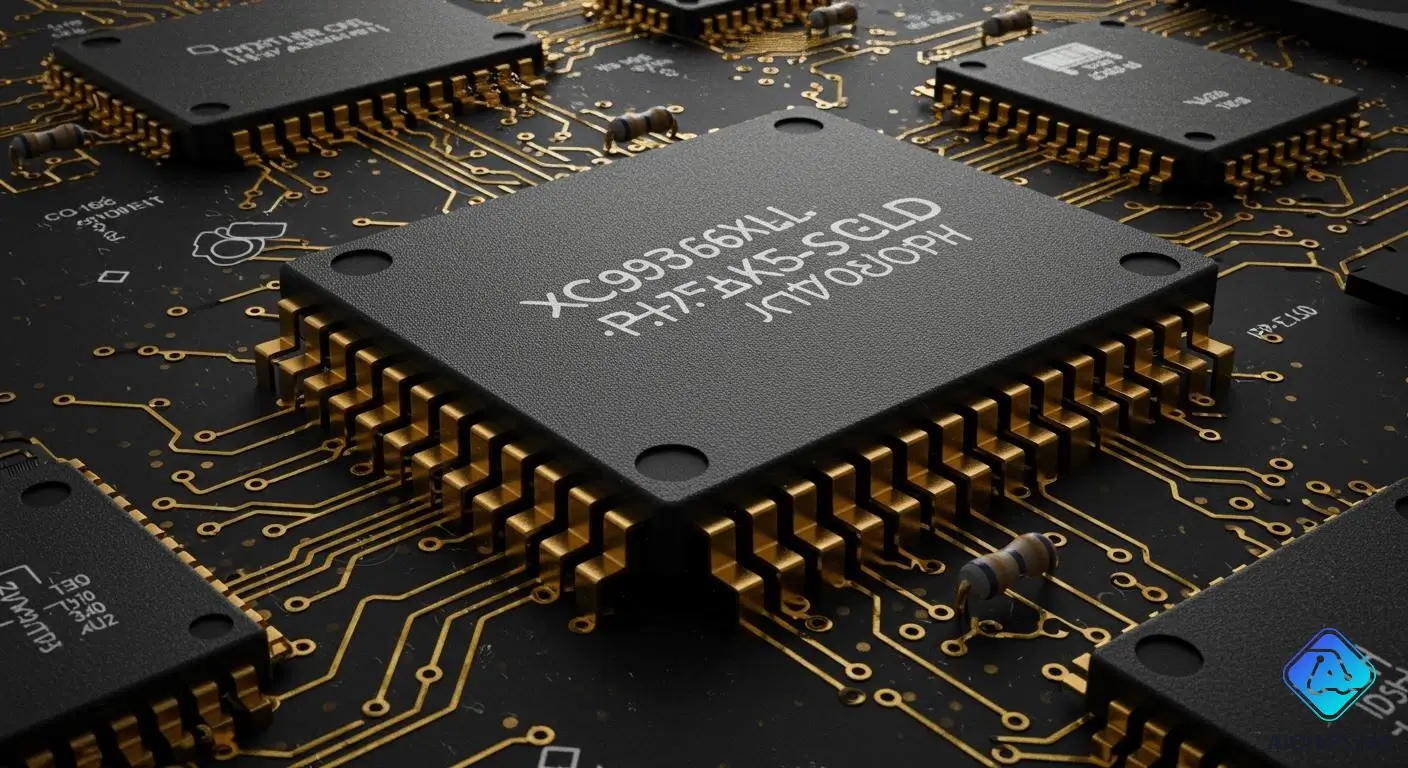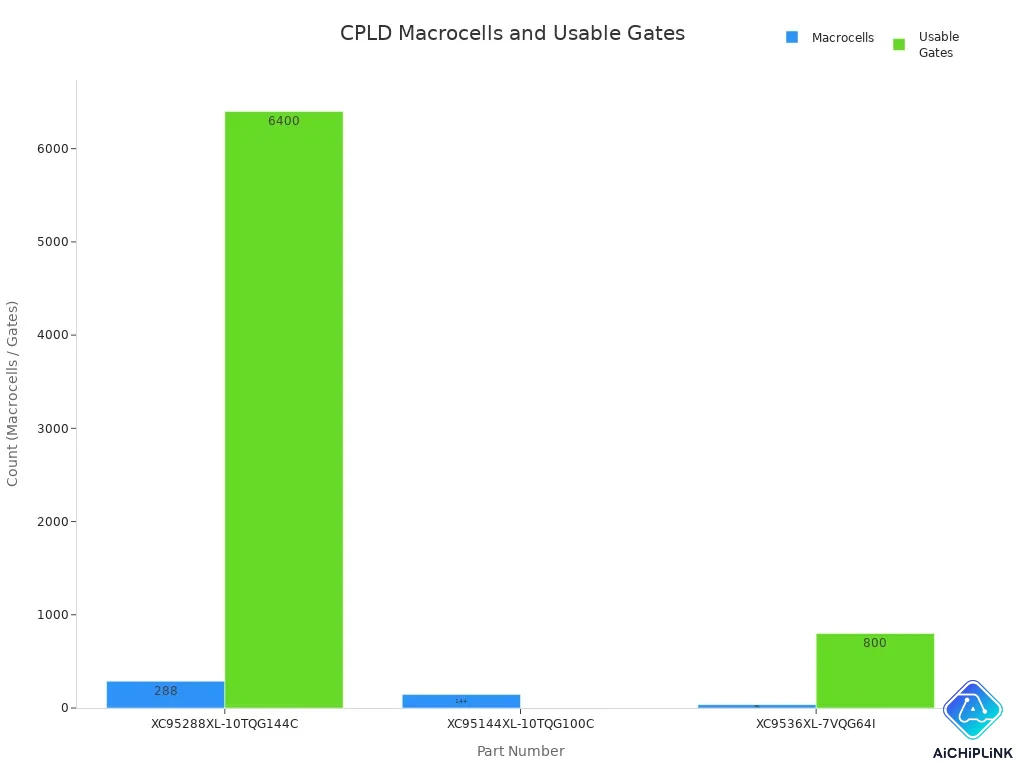
You can use the XC9536XL-5CS48C CPLD in digital circuits. This chip works well for small spaces. It runs at 3.3 volts. It is good for compact electronic designs. The chip has 36 macrocells and 800 usable gates. It gives a fast 5 ns pin-to-pin delay. It can reach speeds up to 178 MHz. You can trust it to work between 3.0V and 3.6V. It works well in normal temperature ranges. Its power modes help you save energy or boost speed. Manufacturers do not make this device anymore. You may want to look at newer options.
Key Takeaways
- The XC9536XL-5CS48C CPLD is small and uses 3.3 volts. This makes it good for tiny electronic projects. It has 36 macrocells and 800 usable gates. This chip helps with logic and control jobs in digital circuits. Always check the official datasheet for details and pin uses before you begin your project. Think about using newer CPLDs for future work. The XC9536XL-5CS48C is discontinued and may not get support. This chip works well in communications, embedded systems, and digital controllers. It is fast and does not use much power.
Overview of XC9536XL-5CS48C CPLD
The XC9536XL-5CS48C CPLD is made by AMD Xilinx. AMD Xilinx is a top company for programmable logic devices. This chip is fast and works well in digital projects. AMD Xilinx has made programmable technology for a long time. This chip shows their skill in making these devices. It uses 3.3 volts, which is common in new digital systems. The chip is small, so it fits in tight spaces. It also gives strong performance.
Main Features
The XC9536XL-5CS48C CPLD has many good features:
-
There are 36 macrocells and about 800 usable gates. These help you make simple logic and control tasks.
-
The chip has a fast 5 ns minimum delay. This means your circuits can react quickly.
-
It can work at speeds up to 178 MHz. This is fast for many digital uses.
-
The chip works between 3.0V and 3.6V. This is good for low-power designs.
-
Its small size helps save space on your circuit board.
Note: The 3.3V power is important for new electronics. It helps use less power and keeps things fast. You can use this chip in phones, cars, and home devices.
You can compare the XC9536XL-5CS48C CPLD with other CPLDs. The table below shows how it matches up with similar chips:
| Part Number | Manufacturer | Key Features | Use Case/Notes |
|---|---|---|---|
| XC95288XL-10TQG144C | AMD / Xilinx | 288 macrocells (≈ 6,400 usable gates), 3.3 V core, 5 V-tolerant inputs, moderate speed | Good for more complex logic and medium control tasks. |
| XC95144XL-10TQG100C | AMD / Xilinx | 144 macrocells, 5 V-tolerant I/Os, power management options | Used for connecting protocols and memory address tasks. |
| XC9536XL-7VQG64I | AMD / Xilinx | 36 macrocells (~800 gates), made for 3.3 V systems | Best for small control jobs and simple logic. |

Technical Specs
Here are the main technical details for the XC9536XL-5CS48C CPLD. The table below lists the most important ones:
| Specification | Value |
|---|---|
| Maximum Operating Frequency | 178 MHz |
| Minimum Propagation Delay | 5 ns |
The chip works between 3.0V and 3.6V. This helps it use less power and work well. It is a good pick for many digital systems.
You should know the XC9536XL-5CS48C CPLD is not made anymore. AMD Xilinx stopped making it because fewer people wanted it. It was also hard to get parts for older chips. The table below shows why they stopped making it:
| Reason for Discontinuation | Details |
|---|---|
| Declining Run-Rate | Fewer old chips were made, so it was hard to keep making them. |
| Supplier Sustainability | It was tough to find parts for old chips, and it cost more as tech changed. |
| Last Time Buy (LTB) Date | The last day to order is June 29, 2024. |
You might want to try newer CPLDs for your next project. Newer chips have more features and better support for today’s designs.
Pinout and Package
Pinout Diagram
You need to know where each pin connects on the XC9536XL-5CS48C CPLD. This chip uses a CS48 package. It has 48 pins arranged in a square. Each side has 12 pins. You can see the pinout in the diagram below:
+-----------------------+
1| o o |48
2| o o |47
3| o o |46
4| o o |45
5| o o |44
6| o o |43
7| o o |42
8| o o |41
9| o o |40
10| o o |39
11| o o |38
12| o o |37
+-----------------------+
You can find a full pinout diagram in the official datasheet. Always check the datasheet before you start wiring your circuit.
Pin Functions
Each pin on the XC9536XL-5CS48C CPLD has a special job. Some pins handle power. Some pins connect to your logic signals. Here are the main types of pins you will see:
-
VCC: These pins give power to the chip. You must connect them to 3.3V.
-
GND: These pins go to ground. They complete the circuit.
-
I/O Pins: You use these pins to send and receive digital signals. You can program them for different tasks.
-
JTAG Pins: These pins help you program and test the chip. They use a standard called JTAG.
-
CLK: This pin takes in the clock signal. The chip uses this to time its actions.
Tip: Always double-check the pin functions before you connect anything. Wrong connections can damage the chip.
Package Info
The XC9536XL-5CS48C CPLD comes in a CS48 package. CS stands for "Chip Scale." This package is very small. It measures about 7 mm by 7 mm. The pins sit close to the edge. This helps you save space on your circuit board. You can use this chip in small devices like handheld gadgets or compact controllers.
-
Package Type: CS48 (Chip Scale, 48 pins)
-
Dimensions: About 7 mm x 7 mm
-
Pin Pitch: Each pin sits about 0.5 mm apart
Note: The small size makes this chip a good choice for tight spaces. You need careful soldering skills to place it on your board.
Datasheet and Documentation
Accessing the Datasheet
You need the official datasheet to understand how to use the XC9536XL-5CS48C CPLD in your project. The datasheet gives you all the technical details, pin descriptions, and electrical limits.
Tip: Always download the datasheet from a trusted website. This helps you avoid errors and keeps your project safe.
Key Datasheet Details
The datasheet for the XC9536XL-5CS48C CPLD gives you the most important facts about the chip. You can use this information to plan your circuit and make sure you meet all the requirements. Here is a table with the key details you will find:
| Specification | Details |
|---|---|
| Pin-to-pin logic delays | 5 ns |
| System frequency | Up to 178 MHz |
| Number of macrocells | 36 |
| Usable gates | 800 |
| Package options | 44-pin PLCC, 44-pin VQFP, 48-pin CSP, 64-pin VQFP |
| User I/O pins | 34 (44-pin PLCC/VQFP), 36 (48-pin CSP/VQFP) |
You should check the datasheet before you start your design. The datasheet also explains how to connect power, ground, and I/O pins. It lists the safe voltage range and gives you timing diagrams. If you follow the datasheet, you can avoid common mistakes and make your project work well.
Applications and Alternatives
Typical Uses
The XC9536XL-5CS48C CPLD can be used in many digital devices. This chip is good for communications equipment. It is found in things that need to work fast and use little power. The chip helps save energy. You can program it while it stays on the board, so updates are simple. It works with different FPGA families. This lets you share logic jobs between chips. Here are some ways people use it:
-
Communications systems that need to be fast and reliable
-
Computers that must use less power
-
Digital controllers for small machines
-
Signal processing in embedded systems
This chip is great for projects that need quick action and low power.
Industry Examples
You might see the XC9536XL-5CS48C CPLD in real products. Many engineers pick it for small projects. The chip fits well on tiny boards. You can change its logic without taking it off. This is helpful if you need to fix your design fast. The chip is good for embedded systems that need fast logic. You can use it for testing or finished products. Here are some examples:
-
Small CPLD learning boards for students and hobbyists
-
Prototyping boards in research labs
-
Embedded controllers in consumer electronics
The chip’s surface-mount package is good for small spaces.
Alternative CPLDs
You might want to try other CPLDs for new projects. The XC9536XL-5CS48C CPLD is not made anymore. New chips have more features and better support. Here is a table with some other choices you can use:
| Part Number | Manufacturer | Key Features | Notes |
|---|---|---|---|
| XC2C64A-6VQG44C | AMD Xilinx | 64 macrocells, 1.8V/3.3V I/O | Low power, small footprint |
| ATF1504AS-10JU | Microchip | 64 macrocells, 5V I/O | Good for legacy systems |
| EPM240T100C5N | Intel/Altera | 240 logic elements, 3.3V I/O | High density, modern design |
Always read the datasheet for each chip before you pick one for your project.
You learned that the XC9536XL-5CS48C CPLD offers fast speed, low power use, and a small size. You can use it in many digital projects.
-
Always check the datasheet before you start your design.
-
Look at newer CPLDs since this chip is discontinued.
Think about your project needs. Choose the CPLD that fits your goals best.

Written by Jack Elliott from AIChipLink.
AIChipLink, one of the fastest-growing global independent electronic components distributors in the world, offers millions of products from thousands of manufacturers, and many of our in-stock parts is available to ship same day.
We mainly source and distribute integrated circuit (IC) products of brands such as Broadcom, Microchip, Texas Instruments, Infineon, NXP, Analog Devices, Qualcomm, Intel, etc., which are widely used in communication & network, telecom, industrial control, new energy and automotive electronics.
Empowered by AI, Linked to the Future. Get started on AIChipLink.com and submit your RFQ online today!
Frequently Asked Questions
What is a CPLD and how does it work?
A CPLD, or Complex Programmable Logic Device, lets you create custom digital circuits. You program it to perform logic tasks. You can use it for control, timing, or connecting different parts of your project.
Can you reprogram the XC9536XL-5CS48C CPLD?
Yes, you can reprogram this CPLD many times. You use JTAG pins and special software. This makes it easy to update your design without removing the chip.
What tools do you need to program this CPLD?
You need a JTAG programmer and software like Xilinx ISE. The software lets you write and load your logic design onto the chip.
Is the XC9536XL-5CS48C CPLD still available for new designs?
You should not use this chip for new designs. The manufacturer stopped making it. You can choose newer CPLDs with better support and more features.